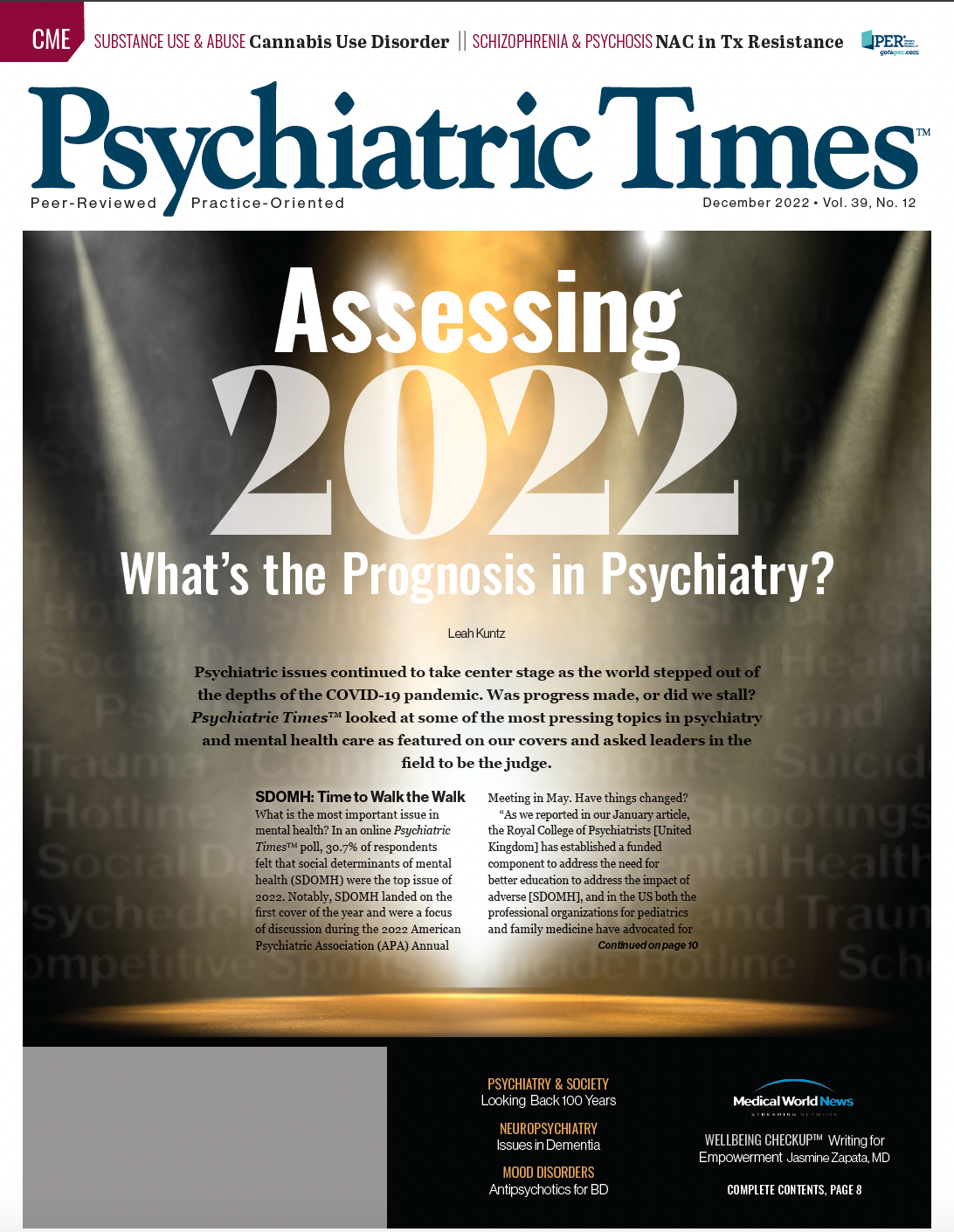CME
Article
Psychiatric Times
Current Treatments for Cannabis Use Disorder
Author(s):
While there are no FDA-approved medications available for CUD, some studies show potential off-label utility in mitigating withdrawal and maintaining abstinence. Learn more in this CME article.
andreaobzerova/AdobeStock
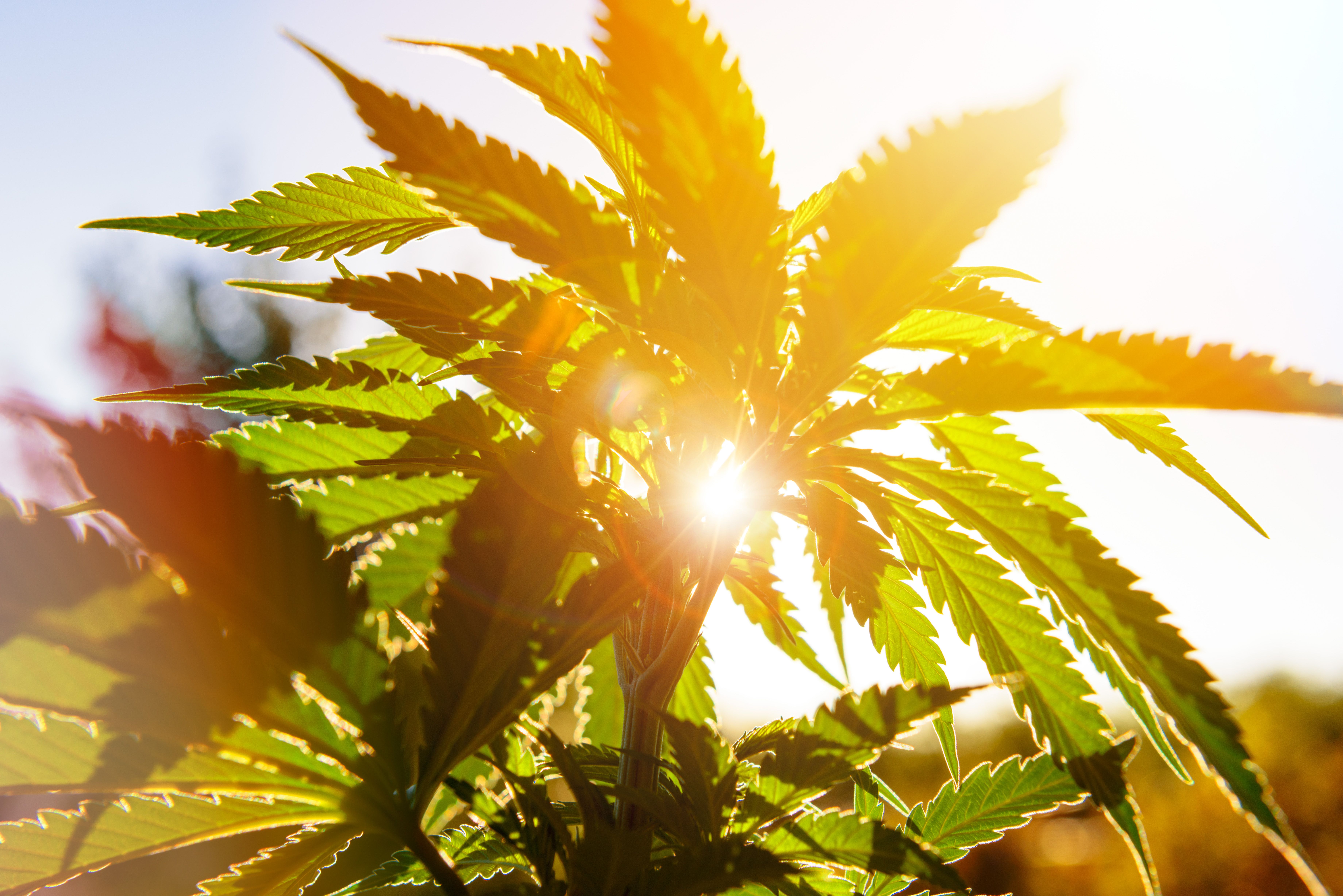
CATEGORY 1 CME
Premiere Date: December 20, 2022
Expiration Date: June 20, 2024
This activity offers CE credits for:
1. Physicians (CME)
2. Other
All other clinicians either will receive a CME Attendance Certificate or may choose any of the types of CE credit being offered.
ACTIVITY GOAL
The goal of this activity is to evaluate evidence-based behavioral treatments, medications, and management strategies for cannabis use disorder.
LEARNING OBJECTIVES
1. Review the available evidence-based behavioral treatments for cannabis use disorder.
2. Review evidence of off-label pharmacological options to aid in the management of cannabis use disorder.
TARGET AUDIENCE
This accredited continuing education (CE) activity is intended for psychiatrists, psychologists, primary care physicians, physician assistants, nurse practitioners, and other health care professionals seeking to improve the care of patients with mental health disorders.
ACCREDITATION/CREDIT DESIGNATION/FINANCIAL SUPPORT
This activity has been planned and implemented in accordance with the accreditation requirements and policies of the Accreditation Council for Continuing Medical Education (ACCME) through the joint providership of Physicians’ Education Resource®, LLC, and Psychiatric Times™. Physicians’ Education Resource®, LLC, is accredited by the ACCME to provide continuing medical education for physicians.
Physicians’ Education Resource®, LLC, designates this enduring material for a maximum of 1.5 AMA PRA Category 1 Credits™. Physicians should claim only the credit commensurate with the extent of their participation in the activity.
This activity is funded entirely by Physicians’ Education Resource®, LLC. No commercial support was received.
OFF-LABEL DISCLOSURE/DISCLAIMER
This accredited CE activity may or may not discuss investigational, unapproved, or off-label use of drugs. Participants are advised to consult prescribing information for any products discussed. The information provided in this accredited CE activity is for continuing medical education purposes only and is not meant to substitute for the independent clinical judgment of a physician relative to diagnostic or treatment options for a specific patient’s medical condition. The opinions expressed in the content are solely those of the individual faculty members and do not reflect those of Physicians’ Education Resource®, LLC.
FACULTY, STAFF, AND PLANNERS’ DISCLOSURES AND CONFLICT OF INTEREST (COI) MITIGATION
None of the staff of Physicians’ Education Resource®, LLC, or Psychiatric Times™ or the planners of this educational activity have relevant financial relationship(s) to disclose with ineligible companies whose primary business is producing, marketing, selling, reselling, or distributing health care products used by or on patients. Dr Mooney and Dr Lochte have nothing to disclose. Dr Cooper disclosed that she is a consultant for, and has done research for, Canopy Growth Corporation.
For content-related questions, email us at PTEditor@mmhgroup.com. For questions concerning the accreditation of this CE activity or how to claim credit, please contact info@gotoper.com and include “Current Treatments for Cannabis Use Disorder” in the subject line.
HOW TO CLAIM CREDIT
Once you have read the article, please use the following URL to evaluate and request credit: https://education.gotoper.com/activity/ptcme22dec. If you do not already have an account with Physicians’ Education Resource®, LLC, you will be prompted to create one. You must have an account to evaluate and request credit for this activity.
Cannabis is the most widely used psychoactive substance after alcohol and tobacco; 4% of the global adult population (200 million people) endorses its use (Figure 1). Cannabis use disorder (CUD) is defined by an inability to stop a problematic pattern of use despite significant negative consequences. CUD has traditionally been thought to affect 1 in 10 people who use cannabis, but recent evidence has indicated that the lifetime incidence may be closer to 1 in 5.1
Figure 1. Past Month Substance Use Among People Aged 12 Years or Older: 2019
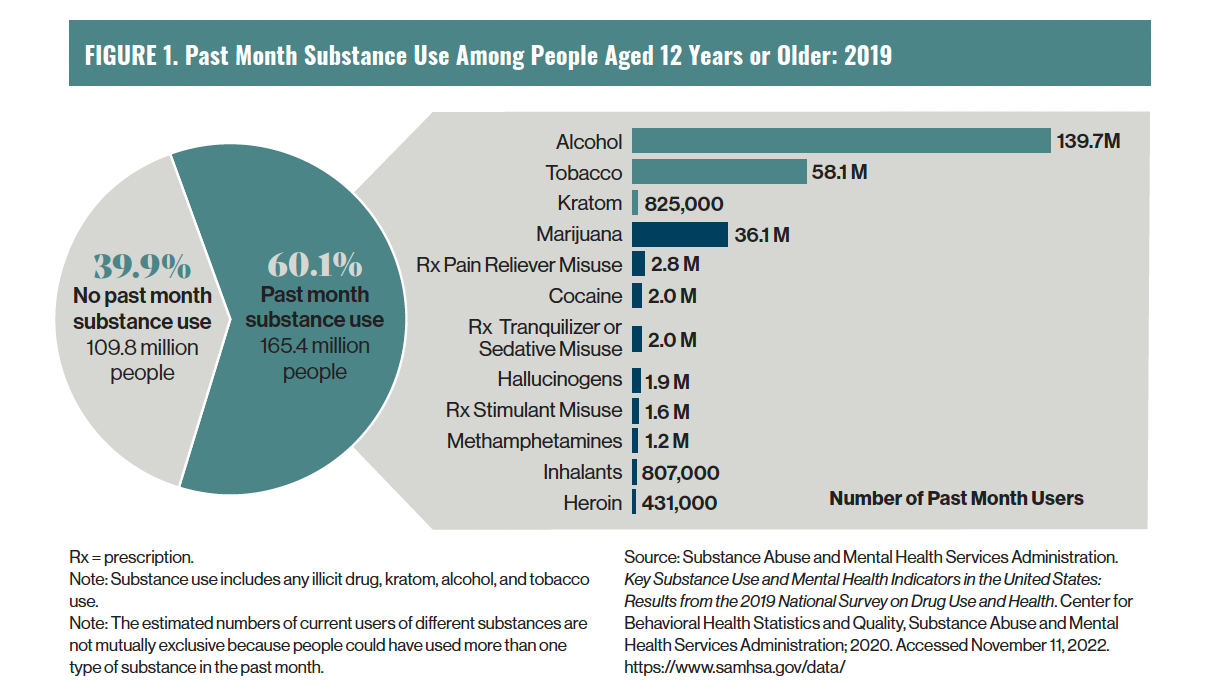
In the United States, there are nearly 14 million daily or near-daily cannabis users; the prevalence doubled between 2010 and 2019.2 Increased rates of cannabis use likely follow changes in legalization and social acceptance; reduced cost; increased potency; and expanded preparation and routes of administration (ie, edibles, waxes, extracts, and vaping). Despite reduced public perception of risk, research has shown that heavy cannabis use is associated with neurocognitive impairment, psychiatric and medical comorbidities, as well as disruption of employment and educational functioning.3 Individuals who meet criteria for CUD (Table 1) often feel ambivalent about treatment, and those who do seek treatment generally have multiple failed quit attempts.4 Currently, there are few effective and long-lasting treatment options.
Table 1. Diagnostic Criteria for CUD4
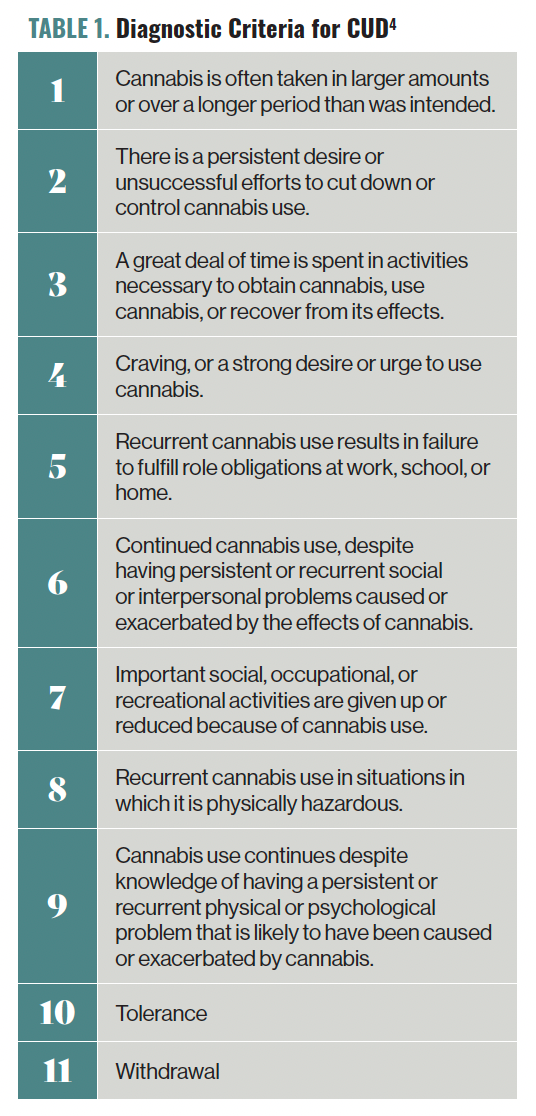
For patients seeking treatment for CUD, goals can include sustained abstinence, reduced use, or harm reduction. Treatment of CUD typically occurs in the outpatient setting; however, residential or inpatient treatment may be required for more complex cases.
Behavioral interventions for substance use disorders are the mainstay of treatment and have evidence for efficacy in reducing use and facilitating abstinence. There are currently no US Food and Drug Administration (FDA)-approved pharmacological treatments for CUD.5 However, in clinical studies, some medications show promise for treating CUD. The decision to incorporate pharmacological treatment should be done with the understanding that efficacy, and in some cases, safety and tolerability, are still unclear. Regardless of modality, close follow-up early in the treatment course is often beneficial. With the patient’s permission, interval drug testing and/or the involvement of collateral contacts can be helpful for assessing progress. A theoretical treatment algorithm for CUD is provided (Figure 2) for clinicians considering pharmacological approaches in addition to behavioral interventions.
Figure 2. A Theoretical Treatment Algorithm for CUD With the Goal of Abstinence
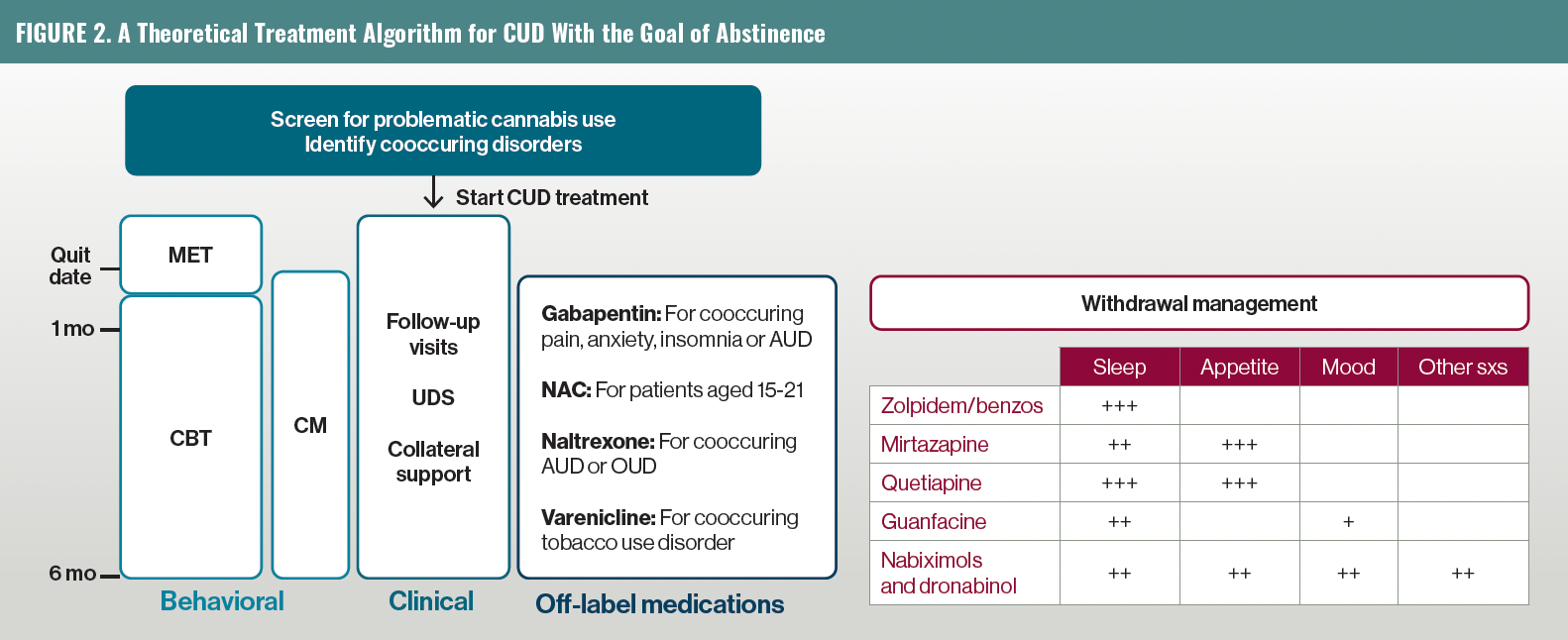
Evidence-Based Behavioral Treatments
Various behavioral approaches have been shown to have clinical utility in treating CUD. In a meta-analysis of 7 controlled clinical trials of adults with CUD, psychosocial treatments were shown to double the chances of abstinence at 3 to 4 months’ follow-up (21% versus 10%).6 Treatment outcomes improve with longer durations of therapy and when interventions are combined. However, access to evidence-based therapies is often limited, insurance reimbursement may constrain options, and poor adherence to treatments is common. Even with evidence-based psychosocial treatment, abstinence rates remain modest (~20%) and patients have difficulty in maintaining treatment gains after 9 months.7 Although clinicians should continue to screen for CUD and provide assistance in treatment, a recent systematic review showed limited evidence for brief interventions to enhance motivation.8
Motivational enhancement therapy (MET). MET is an empathetic approach, focusing on individualized goals and psychoeducation. MET is often less time and resource intensive than cognitive-behavioral therapy (CBT), and some studies show that their efficacy in treating CUD is similar.9 MET may be ideal for patients who are ambivalent or who are just starting treatment. It can reduce cannabis use early in treatment; however, effects may not be sustained 1 month after treatment.
Contingency management (CM). CM uses incentives like vouchers or prizes to reinforce milestones in treatment, such as adherence to treatment or negative drug screens. Although CM has limited efficacy as a monotherapy in CUD, it can promote longer periods of abstinence when combined with other treatment modalities like MET or CBT.10
Cognitive-behavioral therapy. CBT is a well-studied approach focusing on the thoughts, behaviors, and triggers that reinforce substance use. This approach encourages patients to utilize coping skills and problem-solving skills and to find healthy alternative behaviors to replace substance use. It should be considered as a first-line treatment for highly motivated patients or patients who have already started treatment, but it may have limited utility in more ambivalent patients. Current evidence best supports MET plus CBT-based interventions with the addition of CM, specifically when the treatment duration is more than 4 sessions and extends past 1 month.7
Other interventions. Other psychosocial treatments (ie, counseling, family-based therapy, mindfulness, and relapse prevention) likely have utility in treating CUD, but they have relatively less supporting research.7 Although mutual support groups are popular and valuable resources for some patients, they should ideally be utilized in addition to evidence-based psychosocial treatments.
Medications to Reduce Cannabis Use
Given the limitations of behavioral interventions, pharmacological interventions have been actively researched over the past 20 years. However, there are still no FDA-approved medications to treat CUD. Although some medications may have potential clinical utility for off-label use, clear treatment recommendations with respect to both safety and efficacy cannot be made without additional clinical trials.5 Off-label use of FDA-approved medications is sometimes considered in combination with behavioral treatments to target withdrawal symptoms, craving, or relapse, or to augment behavioral treatment approaches.
The following medications have been approved by the FDA for alternative indications and may have efficacy in reducing cannabis use. They are listed in order of likelihood of clinical use (determined by a subjective mix of provider familiarity, treatment of comorbidities, safety/tolerability, and strength of preliminary evidence of efficacy) rather than by evidence of efficacy. For example, gabapentin is ranked highly and listed first because it is commonly used, is well tolerated, and can reduce cooccurring anxiety/insomnia symptoms,11 despite the fact that it has relatively less evidence for efficacy in reducing cannabis use. This ordering prioritizes minimization of iatrogenic harm, given that the clinical benefits of all listed medications are yet to be verified for CUD.
Gabapentin. Gabapentin is a medication that blocks the α٢δ subunit of voltage-gated calcium channels and indirectly modulates γ-aminobutyric acid (GABA) signaling. The FDA has approved it for a variety of conditions including neuropathic pain, and it is frequently used off-label for anxiety and insomnia, and to treat craving associated with alcohol withdrawal. In a placebo-controlled trial (N=50), gabapentin administered at 1200 mg/day showed significant reductions in objective and subjective markers of cannabis use, withdrawal, and craving.12
N-acetylcysteine (NAC). NAC is a prodrug of the amino acid cysteine, and it plays a role in controlling glutamate levels. It has been FDA-approved for more than 50 years and is beneficial in preventing liver damage associated with acetaminophen overdose. In a randomized controlled trial (RCT) of individuals aged 15 to 21 years with CUD, participants (N=58) taking NAC at a dose of 1200 mg twice a day had twice the odds of having a negative urine cannabinoid test relative to those assigned to placebo (N=58).13 The results of this study were not replicated in adults, but subgroup analysis found better results in younger adults, possibly indicating an age effect.14
Naltrexone. Naltrexone is a µ-opioid receptor antagonist that is approved by the FDA to treat opioid and alcohol use disorders. Single doses of naltrexone (12-100 mg) have been found to enhance misuse-related effects of cannabis.15 Moreover, daily administration of naltrexone (50 mg) for 3 weeks reduced cannabis self-administration and use in people not seeking treatment for CUD.16
Varenicline. Varenicline is a selective nicotinic acetylcholine receptor agonist approved for tobacco smoking cessation. In a placebo-controlled pilot trial (N=72), treatment with varenicline was associated with greater rates of cannabis abstinence compared with placebo.17 In a placebo-controlled laboratory study of co-users of nicotine and cannabis, the combination of varenicline and nabilone resulted in increased tobacco cessation and attenuated cannabis withdrawal symptoms, but it did not demonstrate a reduction in cannabis relapse.18
Nabilone. Nabilone is a cannabinoid 1 (CB1) receptor agonist with greater CB1 receptor affinity and efficacy, and superior bioavailability compared with oral Δ-9-tetrahydrocannabinol (THC), the primary psychoactive constituent of cannabis. Similar to cannabis, it has misuse potential. Nabilone is FDA approved as a second-line treatment for nausea and vomiting associated with chemotherapy. In a laboratory study, 6 to 8 mg/day of nabilone reduced cannabis use in a laboratory model of relapse and reduced symptoms of cannabis withdrawal.19
Cannabidiol (CBD). CBD is the second most abundant phytocannabinoid in cannabis and cannabis-based products after THC. It is nonintoxicating, has a favorable safety profile, and is the principal compound of Epidiolex, which is FDA-approved for specific seizure disorders. Unlike THC, it has minimal direct actions at the CB1 and CB2 receptors. In a recent RCT with individuals seeking treatment for CUD (N=48), oral CBD (400-800 mg/day) was associated with reduced cannabis use, favorable retention, and no significant adverse events.20 Of note, commercially available OTC CBD products should not be used for medical treatment because they usually contain lower doses of CBD (eg, 5-100 mg) than those administered in these studies, are generally not manufactured according to the Good Manufacturing Practices, and frequently contain THC.
Management of Cannabis Withdrawal
Table 2. Common Symptoms Associated With Cannabis Withdrawal

Cannabis withdrawal symptoms (Table 2) often appear 1 day after abstinence; they peak on days 2 to 6 and remit at around 2 weeks. Most cannabis withdrawal symptoms are mild and resolve without treatment or with conservative interventions like exercise, relaxation techniques, and over-the-counter analgesics. However, if these symptoms become unmanageable, they can lead to relapse.
Nabiximols. Nabiximols is an oromucosal spray that delivers 2.7 mg THC and 2.5 mg CBD per actuation. The FDA has not approved nabiximols for any indication in the United States; however, it is approved in many countries for indications that include chronic pain and multiple sclerosis. In an RCT, it was shown to reduce overall severity of withdrawal as well as the duration of withdrawal.21 In a separate RCT, it was shown to reduce days of cannabis use and was well tolerated.22
Dronabinol. Dronabinol is an oral synthetic THC, and it has an FDA-approved indication for treating anorexia and for treating nausea in specific medical conditions. It has been shown to reduce general cannabis withdrawal symptoms without producing intoxication, but has failed to prevent relapse.23,24
Quetiapine. Quetiapine is an atypical antipsychotic that acts at multiple neurotransmitter receptors, and it is used for its sedating and mood-stabilizing properties at lower doses. It is FDA approved for treatment of acute manic episodes as well as depressive episodes in bipolar disorder. At a dose of 200 mg, this medication was shown to attenuate sleep and appetite issues caused by cannabis withdrawal; however, it did not reduce relapse and may increase drug craving.25 Other studies have demonstrated a reduction in CUD severity with higher doses of this medication, but participants reported adverse effects of fatigue and somnolence.26
Mirtazapine. Mirtazapine is an FDA-approved antidepressant known for its sedating and appetite-inducing properties. Mirtazapine enhances noradrenergic and serotonergic transmission by blocking presynaptic inhibitory α2 auto receptors. It has been found to improve appetite and sleep; however, it had no effect in reducing cannabis use in a laboratory model of relapse.27
Zolpidem and benzodiazepines. Zolpidem is a benzodiazepine-like sedative hypnotic and GABAA receptor agonist, FDA approved for treating sleep onset insomnia. It has been found to ameliorate the negative changes in sleep quality and architecture seen with cannabis withdrawal.28 Nitrazepam is a short-acting benzodiazepine and GABAA receptor agonist that has been shown to improve objective sleep measures when given to individuals with cannabis withdrawal.29
Guanfacine. Guanfacine is an α2A-adrenergic agonist that has been approved by the FDA to treat attention-deficit/hyperactivity disorder in children and adolescents. In a within-subject study, guanfacine (2 mg at night) reduced ratings of irritability and improved sleep during cannabis withdrawal. The medication was well tolerated but did not reduce cannabis use in a laboratory model of relapse.30 Lofexidine, another α2 adrenergic agonist FDA approved for mitigating symptoms associated with opioid withdrawal, was shown to reduce cannabis withdrawal in a laboratory model of relapse when combined with oral THC.31
Other Treatments
Medications from other drug classes have been tested in the treatment of CUD, but most have shown little or no effect on reducing cannabis use. Some medications, such as topiramate32 and lorcaserin,33 have shown preliminary efficacy in treating CUD, but they have tolerability issues or are no longer FDA approved. Oxytocin has some evidence for supplementing psychosocial interventions,34 but it is unlikely to be used without further study. Novel drugs not yet approved by the FDA for any indication, such as fatty acid amide hydrolase inhibitors, have potential efficacy in treating CUD and are undergoing multisite trials, but they are not available for clinical use at this time.35
Concluding Thoughts
The prevalence of CUD is increasing in lock step with rates of cannabis use due to changes in legalization and other sociopolitical factors. Behavioral interventions are the current mainstay of evidence-based treatment; nevertheless, they can be challenging to implement and show limited efficacy in maintaining long-term abstinence. No FDA-approved medications are available for CUD, but some studies show potential off-label utility in mitigating withdrawal and maintaining abstinence. Further research will be needed to clarify definitive treatment guidelines for this increasingly relevant condition.
Dr Lochte is a psychiatry resident at University of California, Los Angeles (UCLA). Dr Cooper is the director of the UCLA Center for Cannabis and Cannabinoids in the Jane and Terry Semel Institute for Neuroscience and Human Behavior. She is also an associate professor-in-residence in the Department of Psychiatry and Biobehavioral Sciences at UCLA’s David Geffen School of Medicine. Dr Mooney is an addiction psychiatrist and associate clinical professor at UCLA, where she directs the UCLA Addiction Medicine Clinic.
References
1. Leung J, Chan GCK, Hides L, Hall WD. What is the prevalence and risk of cannabis use disorders among people who use cannabis? a systematic review and meta-analysis. Addict Behav. 2020;109:106479.
2. United Nations Office of Drug and Crime. World Drug Report 2021 – Drug Market Trends: Cannabis Opioids. June 2021. Accessed November 11, 2022. https://www.unodc.org/res/wdr2021/field/WDR21_Booklet_3.pdf
3. World Health Organization (WHO). The health and social effects of nonmedical cannabis use. 2016. Accessed November 11, 2022. https://www.who.int/publications/i/item/9789241510240
4. Hughes JR, Peters EN, Callas PW, et al. Attempts to stop or reduce marijuana use in non-treatment seekers. Drug Alcohol Depend. 2008;97(1-2):180-184.
5. Brezing CA, Levin FR. The current state of pharmacological treatments for cannabis use disorder and withdrawal. Neuropsychopharmacology. 2018;43(1):173-194.
6. Patnode CD, Perdue LA, Rushkin M, et al. Screening for unhealthy drug use: updated evidence report and systematic review for the US Preventive Services Task Force. JAMA. 2020;323(22):2310-2328.
7. Gates PJ, Sabioni P, Copeland J, et al. Psychosocial interventions for cannabis use disorder. Cochrane Database Syst Rev. 2016;(5):CD005336.
8. Imtiaz S, Roerecke M, Kurdyak P, et al. Brief interventions for cannabis use in healthcare settings: systematic review and meta-analyses of randomized trials. J Addict Med. 2020;14(1):78-88.
9. Stephens RS, Roffman RA, Curtin L. Comparison of extended versus brief treatments for marijuana use. J Consult Clin Psychol. 2000;68(5):898-908.
10. Carroll KM, Easton CJ, Nich C, et al. The use of contingency management and motivational/skills-building therapy to treat young adults with marijuana dependence. J Consult Clin Psychol. 2006;74(5):955-966.
11. Ahmed S, Bachu R, Kotapati P, et al. Use of gabapentin in the treatment of substance use and psychiatric disorders: a systematic review. Front Psychiatry. 2019;10:228.
12. Mason BJ, Crean R, Goodell V, et al. A proof-of-concept randomized controlled study of gabapentin: effects on cannabis use, withdrawal and executive function deficits in cannabis-dependent adults. Neuropsychopharmacology. 2012;37(7):1689-1698.
13. Gray KM, Carpenter MJ, Baker NL, et al. A double-blind randomized controlled trial of N-acetylcysteine in cannabis-dependent adolescents. Am J Psychiatry. 2012;169(8):805-812.
14. Gray KM, Sonne SC, McClure EA, et al. A randomized placebo-controlled trial of N-acetylcysteine for cannabis use disorder in adults. Drug Alcohol Depend. 2017;177:249-257.
15. Cooper ZD, Haney M. Opioid antagonism enhances marijuana’s effects in heavy marijuana smokers. Psychopharmacology (Berl). 2010;211(2):141-148.
16. Haney M, Ramesh D, Glass A, et al. Naltrexone maintenance decreases cannabis self-administration and subjective effects in daily cannabis smokers. Neuropsychopharmacology. 2015;40(11):2489-2498.
17. McRae-Clark AL, Gray KM, Baker NL, et al. Varenicline as a treatment for cannabis use disorder: a placebo-controlled pilot trial. Drug Alcohol Depend. 2021;229(Pt B):109111.
18. Herrmann ES, Cooper ZD, Bedi G, et al. Varenicline and nabilone in tobacco and cannabis co-users: effects on tobacco abstinence, withdrawal and a laboratory model of cannabis relapse. Addict Biol. 2019;24(4):765-776.
19. Haney M, Cooper ZD, Bedi G, et al. Nabilone decreases marijuana withdrawal and a laboratory measure of marijuana relapse. Neuropsychopharmacology. 2013;38(8):1557-1565.
20. Freeman TP, Hindocha C, Baio G, et al. Cannabidiol for the treatment of cannabis use disorder: a phase 2a, double-blind, placebo-controlled, randomised, adaptive Bayesian trial. Lancet Psychiatry. 2020;7(10):865-874.
21. Allsop DJ, Copeland J, Lintzeris N, et al. Nabiximols as an agonist replacement therapy during cannabis withdrawal: a randomized clinical trial. JAMA Psychiatry. 2014;71(3):281-291.
22. Lintzeris N, Bhardwaj A, Mills L, et al; Agonist Replacement for Cannabis Dependence (ARCD) Study Group. Nabiximols for the treatment of cannabis dependence: a randomized clinical trial. JAMA Intern Med. 2019;179(9):1242-1253.
23. Haney M, Hart CL, Vosburg SK, et al. Marijuana withdrawal in humans: effects of oral THC or divalproex. Neuropsychopharmacology. 2004;29(1):158-170.
24. Levin FR, Mariani JJ, Brooks DJ, et al. Dronabinol for the treatment of cannabis dependence: a randomized, double-blind, placebo-controlled trial. Drug Alcohol Depend. 2011;116(1-3):142-150.
25. Cooper ZD, Foltin RW, Hart CL, et al. A human laboratory study investigating the effects of quetiapine on marijuana withdrawal and relapse in daily marijuana smokers. Addict Biol. 2013;18(6):993-1002.
26. Mariani JJ, Pavlicova M, Mamczur AK, et al. Open-label pilot study of quetiapine treatment for cannabis dependence. Am J Drug Alcohol Abuse. 2014;40(4):280-284.
27. Haney M, Hart CL, Vosburg SK, et al. Effects of baclofen and mirtazapine on a laboratory model of marijuana withdrawal and relapse. Psychopharmacology (Berl). 2010;211(2):233-244.
28. Vandrey R, Smith MT, McCann UD, Budney AJ, Curran EM. Sleep disturbance and the effects of extended-release zolpidem during cannabis withdrawal. Drug Alcohol Depend. 2011;117(1):38-44.
29. Allsop DJ, Bartlett DJ, Johnston J, et al. The effects of lithium carbonate supplemented with nitrazepam on sleep disturbance during cannabis abstinence. J Clin Sleep Med. 2015;11(10):1153-1162.
30. Haney M, Cooper ZD, Bedi G, et al. Guanfacine decreases symptoms of cannabis withdrawal in daily cannabis smokers. Addict Biol. 2019;24(4):707-716.
31. Haney M, Hart CL, Vosburg SK, et al. Effects of THC and lofexidine in a human laboratory model of marijuana withdrawal and relapse. Psychopharmacology (Berl). 2008;197(1):157-168.
32. Miranda Jr R, Treloar H, Blanchard A, et al. Topiramate and motivational enhancement therapy for cannabis use among youth: a randomized placebo-controlled pilot study. Addict Biol. 2017;22(3):779-790.
33. Arout CA, Cooper ZD, Collins Reed S, et al. 5HT-2C agonist lorcaserin decreases cannabis self-administration in daily cannabis smokers. Addict Biol. 2021;26(4):e12993.
34. Sherman BJ, Baker NL, McRae-Clark AL. Effect of oxytocin pretreatment on cannabis outcomes in a brief motivational intervention. Psychiatry Res. 2017;249:318-320.
35. D’Souza DC, Cortes-Briones J, Creatura G, et al. Efficacy and safety of a fatty acid amide hydrolase inhibitor (PF-04457845) in the treatment of cannabis withdrawal and dependence in men: a double-blind, placebo-controlled, parallel group, phase 2a single-site randomised controlled trial. Lancet Psychiatry. 2019;6(1):35-45.
